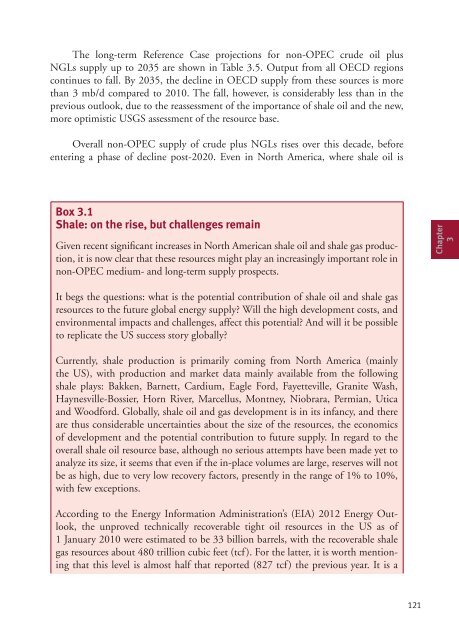World Oil Outlook - Opec
World Oil Outlook - Opec
World Oil Outlook - Opec
- TAGS
- world
- outlook
- opec
- www.opec.org
You also want an ePaper? Increase the reach of your titles
YUMPU automatically turns print PDFs into web optimized ePapers that Google loves.
The long-term Reference Case projections for non-OPEC crude oil plus<br />
NGLs supply up to 2035 are shown in Table 3.5. Output from all OECD regions<br />
continues to fall. By 2035, the decline in OECD supply from these sources is more<br />
than 3 mb/d compared to 2010. The fall, however, is considerably less than in the<br />
previous outlook, due to the reassessment of the importance of shale oil and the new,<br />
more optimistic USGS assessment of the resource base.<br />
Overall non-OPEC supply of crude plus NGLs rises over this decade, before<br />
entering a phase of decline post-2020. Even in North America, where shale oil is<br />
Box 3.1<br />
Shale: on the rise, but challenges remain<br />
Given recent significant increases in North American shale oil and shale gas production,<br />
it is now clear that these resources might play an increasingly important role in<br />
non-OPEC medium- and long-term supply prospects.<br />
It begs the questions: what is the potential contribution of shale oil and shale gas<br />
resources to the future global energy supply? Will the high development costs, and<br />
environmental impacts and challenges, affect this potential? And will it be possible<br />
to replicate the US success story globally?<br />
Currently, shale production is primarily coming from North America (mainly<br />
the US), with production and market data mainly available from the following<br />
shale plays: Bakken, Barnett, Cardium, Eagle Ford, Fayetteville, Granite Wash,<br />
Haynesville-Bossier, Horn River, Marcellus, Montney, Niobrara, Permian, Utica<br />
and Woodford. Globally, shale oil and gas development is in its infancy, and there<br />
are thus considerable uncertainties about the size of the resources, the economics<br />
of development and the potential contribution to future supply. In regard to the<br />
overall shale oil resource base, although no serious attempts have been made yet to<br />
analyze its size, it seems that even if the in-place volumes are large, reserves will not<br />
be as high, due to very low recovery factors, presently in the range of 1% to 10%,<br />
with few exceptions.<br />
According to the Energy Information Administration’s (EIA) 2012 Energy <strong>Outlook</strong>,<br />
the unproved technically recoverable tight oil resources in the US as of<br />
1 January 2010 were estimated to be 33 billion barrels, with the recoverable shale<br />
gas resources about 480 trillion cubic feet (tcf). For the latter, it is worth mentioning<br />
that this level is almost half that reported (827 tcf) the previous year. It is a<br />
121<br />
Chapter<br />
3
















